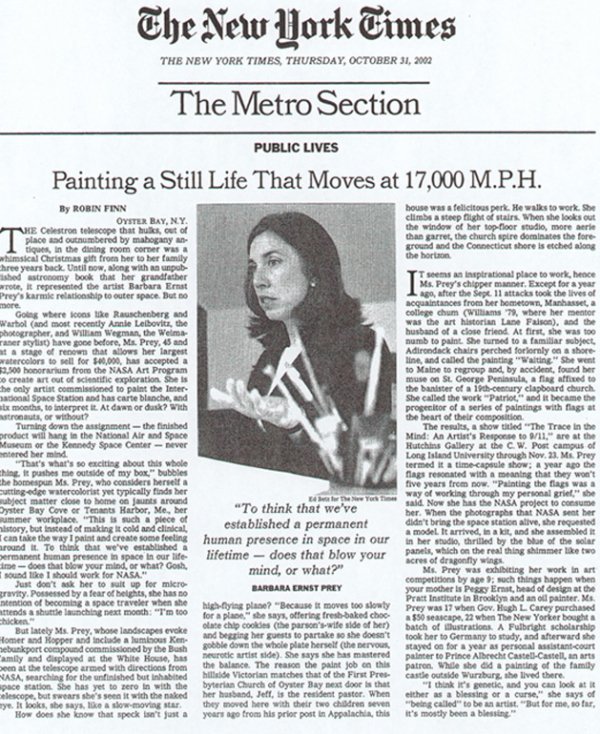Painting a Still Life that Moves at 17,000 M.P.H
The New York Times
October 31st, 2002
The Celestron telescope that hulks, out of place and outnumbered by mahogany antiques, in the dining room corner was a whimsical Christmas gift from her to her family three years back. Until now, along with an unpublished astronomy book that her grandfather wrote, it represented the artist Barbara Ernst Prey’s karmic relationship to outer space. But no more.
Going where icons like Rauschenberg and Warhol (and most recently Annie Leibovitz, the photographer, and William Wegman, the Weimaraner stylist) have gone before, Ms. Prey, 45 and at a stage of renown that allows her largest watercolors to sell for $40,000, has accepted a $2,500 honorarium from the NASA Art Program to create art out of scientific exploration. She is the only artist commissioned to paint the International Space Station and has carte blanche, and has six months, to interpret it. At dawn or dusk? With astronauts, or without?
Turning down the assignment- the finished product will hang in the National Air and Space Museum or the Kennedy Space Center- never entered her mind.
“That’s what’s so exciting about this whole things, it pushes me outside of my box,” bubbles the homespun Ms. Prey, who considers herself a cutting-edge watercolorist yet typically finds her subject matter close to home on jaunts around Oyster Bay Cove or Tenants Harbor, ME, her summer workplace. “This is such a piece of history, but instead of making it cold and clinical, I can take the way I paint and create some feeling around it. To think that we’ve established a permanent human presence in space in our lifetime- does that blow your mind, or what? Gosh, I sound like I should work for NASA.”
Just don’t ask her to suit up for microgravity. Possessed by a fear of heights, she has no intention of becoming a space traveler when she attends a shuttle launching next month: “I’m too chicken.”
But lately Ms. Prey, whose landscapes evoke Homer and Hopper and include a luminous Kennebunkport compounds commissioned by the Bush family and displayed at the White House, has been at the telescope armed with directions from NASA, searching for the unfinished but inhabited space station. She has yet to zero in with the telescope, but she swears she’s seen it with the naked eye. It looks, she says, like a slow-moving star.
How does she know that speck isn’t just a high-flying plane? Because it moves too slowly for a plane,” she says, offering fresh-baked chocolate chip cookies (the parson’s-wife side of her and begging her guests to partake so she doesn’t gobble down the whole plate herself (the nervous, neurotic artist side). She says she has mastered the balance. The reason the paint job on this hillside Victorian matches that of the First Presbyterian Church of Oyster Bay next door is that her husband, Jeff, is the resident pastor. When they moved here with their two children seven years ago from his prior post in Appalachia, this house was a felicitous perk. He walks to work. She climbs a steep flight of stairs. When she looks out the window of her top-floor studio, more aerie than garret, the church spire dominates the foreground and the Connecticut shore is etched along the horizon.
It seems an inspirational place to work, hence Ms. Prey’s chipper manner. Except for a year ago, after the Sept. 11 attacks took the lives of acquaintances from her hometown, Manhasset, a college chum (Williams ’79, where her mentor was the art historian Lane Faison), and the husband of a close friend. At first, she was too numb to paint. She turned to a familiar subject, Adirondack chairs perched forlornly on a shoreline, and called the painting “Waiting.” She went to Maine to regroup and, the Hutchins accident, found her muse on St. George Peninsula, a flag affixed to the banister of a 19th-century clapboard church. She called the work, “Patriot,” and it became the progenitor of a series of paintings with flags at the heart of their composition.
The results, a show titled “The Trace in the Mind: An Artist’s Response to 9\11,” are at the Hutchins Gallery at the C.W. Post campus of Long Island University through Nov. 23. Ms. Prey termed it a time-capsule show; a year ago the flags resonated with a meaning that they won’t five years from now. “Painting the flags was a way of working through my personal grief,” she said. Now she has the NASA project to consume her. When the photographs that NASA sent her didn’t bring the space station alive, she requested a model. It arrived, in a kit, and she assembled it in her studio; thrilled by the blue of the solar panels, which on the real things shimmer like two acres of dragonfly wings.
Ms. Prey was exhibiting her work in art competitions by age 9; such things happen when your mother is Peggy Ernst, head of design at the Pratt Institute in Brooklyn and an oil painter. Ms. Prey was 17 when Gov. Hugh L. Carey purchased a $50 seascape, 22 when The New Yorker bought a batch of illustrations. A Fulbright scholarship took her to Germany to study, and afterward she stayed on for a year as a personal assistant-court painter to Prince Albrecht Castell-Castell, an arts patron. While she did a painting of the family castle outside Wurzburg, she lived there.
“I think it’s genetic, and you can look at it either as a blessing or a curse,” she says of “being called” to be an artist. “But for me, so far, it’s mostly been a blessing.”

